Exploring the Best Grip Tape: A Comprehensive Guide
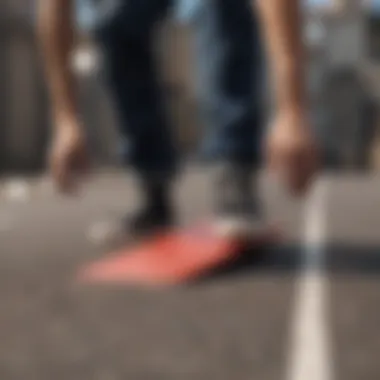

Intro
Grip tape plays a vital role in extreme sports, particularly skateboarding and snowboarding. It is designed to enhance traction and control, making it a critical component for performance. This guide aims to navigate its various types, materials, and performance characteristics. We will also delve into insights about brands and how they cater to specific activities, all while providing practical installation techniques and maintenance tips that are essential for durability.
As you dive into this topic, it is worth noting that selecting the right grip tape can greatly influence not only your experience but also your performance. Such decisions matter, whether for a seasoned athlete or a beginner. Understanding the elements at play increases your confidence, making the activity more enjoyable and potentially safer.
Prelims to Grip Tape
Grip tape plays a crucial role in extreme sports. Its primary function is to provide traction and stability for athletes, ensuring they maintain control over their boards, whether on a skateboard, snowboard, or surfboard. Selecting the right grip tape can significantly impact performance, safety, and overall enjoyment of the sport. In this section, we explore what grip tape is and why it matters.
Definition and Purpose
Grip tape is an adhesive material applied to the surface of sports equipment. It is typically coated with a rough texture, which enhances friction between the user’s footwear and the board. This enhances stability, allowing the athlete to perform tricks and navigate challenging terrain with confidence.
Its purpose extends beyond just added grip. Proper grip tape can absorb shocks, reduce slipping, and even offer a certain degree of cushioning. Athletes need to understand the characteristics of grip tape to choose the most suitable option for their specific sport.
Historical Context
The use of grip tape dates back several decades, with origins linked to skateboarding in the 1970s. The early versions were designed primarily for skateboards, which were gaining popularity at that time. Skateboarders experimented with different materials to improve their traction and performance. As the sports evolved, so did the technology behind grip tape. The introduction of synthetic materials in the 1980s enhanced durability and effectiveness.
Today, grip tape has diversified to serve various extreme sports. Different types of grip tape cater to the needs of skateboarders, snowboarders, and surfers alike. Ongoing advancements in material science continue to redefine what grip tape can do, making it an essential element in the modern athlete's toolkit.
Types of Grip Tape
Understanding the various types of grip tape is crucial for anyone involved in extreme sports, whether as a seasoned expert or a newcomer. Each type of grip tape serves a specific purpose, tailored to the unique challenges and demands of different sports. This section explores the types of grip tape available in the market, their distinct benefits, and pertinent considerations when choosing one.
Skateboard Grip Tape
Skateboard grip tape is arguably the most recognized type of grip tape among extreme sport enthusiasts. Designed primarily for skateboarding, it provides a rough texture that enhances traction between the skateboard and the rider's shoes. This grip is vital as it significantly influences both control and performance.
When selecting skateboard grip tape, thickness is an important factor. Thicker tapes tend to offer extra cushioning and shock absorption, while thinner variations provide a lower profile. Additionally, skateboarding style plays a role in choosing the right tape. For instance, street skaters often prefer a tape that offers a balance between grip and board feel, while vert skaters may lean towards a more aggressive texture for high-speed performance.
Another aspect to consider is the adhesive quality. A strong adhesive ensures that the tape stays securely attached to the board, even during intense tricks. The longevity of the grip tape also matters, with many riders looking for options that resist wear and maintain their grip over time.
Snowboard Grip Tape
Snowboard grip tape, or stomp pads, serves a slightly different purpose than its skateboard counterpart. Positioned on top of a snowboard, it provides crucial traction when a rider is getting on or off the board, especially in slippery conditions. Unlike skateboard grip tape that covers the entire board, snowboard grip tape typically comes in smaller pads.
When evaluating snowboard grip tape, the texture is a vital consideration. Riders often prefer options that balance grip with comfort, as excessive roughness can create discomfort during foot placement. This is especially important for beginners still learning to control their movements on a snowboard.
Environmental conditions are another consideration. Choosing a grip tape that can withstand cold temperatures and moisture is key in snowy conditions. Riders should also look for materials that are resistant to cracking, ensuring long-term performance.
Surfboard Grip Tape
Surfboard grip tape, commonly referred to as deck pads, plays a similar role in water sports as other grip tapes do in land sports. It is designed to create traction between a surfer's feet and the surface of the board, preventing slips during rides on the waves.
The selection of surfboard grip tape is influenced by factors such as the board's design and the type of waves one intends to ride. The material must also be resistant to water damage and sun exposure. Regular surfing can lead to wear and tear; thus, a durable product is required.
Textures of surfboard grip tape can vary. Some mats offer a foam-like cushioning effect, while others feature sharper textures for enhanced grip. Riders should consider their riding style as well; shortboard surfers often prefer a more aggressive grip for quick maneuvers, while longboarders might opt for a softer feel.
Materials Used in Grip Tape Production
The materials used in grip tape production significantly influence its performance, durability, and overall effectiveness. For anyone involved in extreme sports like skateboarding, snowboarding, or surfing, understanding these materials can greatly enhance their experience. A well-chosen grip tape can offer the right amount of traction, ensuring safety and control. This section explores the common materials used in grip tape, their respective advantages, and disadvantages, helping you make informed decisions.
Common Materials
Grip tapes are predominantly made from three main materials:
- Aluminum oxide: This is a popular choice due to its long-lasting properties and exceptional grip. Aluminum oxide powders are used to create a rough surface which excels during maneuvers.
- Silica: Silica offers good traction and is often mixed with other materials to enhance grip. It is less durable compared to aluminum oxide, but it provides decent grip in wet conditions.
- Polymeric composites: These materials are gaining popularity for their versatility. They can be engineered to enhance grip while also being highly resistant to environmental factors like moisture and UV rays.
These materials can be used alone or in combination, depending on the desired application. Each material has its own unique set of properties, making it crucial to choose the right one based on specific requirements.
Advantages and Disadvantages of Materials
When selecting grip tape, weighing the advantages and disadvantages of each material is essential:
- Aluminum oxide
- Silica
- Polymeric composites
- Advantages:
- Disadvantages:
- High durability, providing extended longevity
- Excellent grip for technical maneuvers
- Resistant to wear, even in challenging conditions
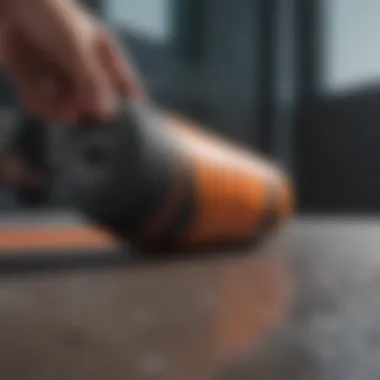
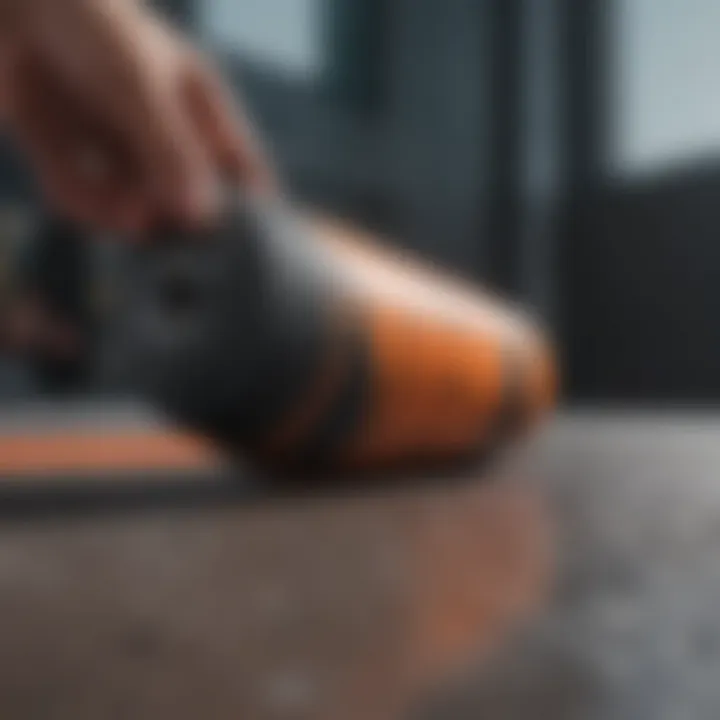
- The initial cost can be higher than alternatives
- Surface can be harsh on bare skin, causing scrapes
- Advantages:
- Disadvantages:
- Good grip range in both wet and dry conditions
- Typically lower cost than aluminum oxide
- Less durable than aluminum oxide, leading to quicker wear
- Grip may smooth out faster under high-stress usage
- Advantages:
- Disadvantages:
- High resistance to environmental factors, prolonging life span
- Versatile designs for aesthetics and functionality
- Some variants can be more costly
- Might not provide as much grip as traditional materials in specific scenarios
Selecting the right grip tape material is not just about preference, but also about the specific conditions and usage patterns for each sport. Knowing the strengths and weaknesses of each material allows thrill-seekers and extreme sports enthusiasts to tailor their gear for the best performance.
"Choosing the right grip tape can not only enhance performance but also ensure safety and control in extreme sports."
Grip Tape Performance Characteristics
Grip tape performance characteristics are crucial in determining how effective a tape will be for its intended use. Understanding these characteristics can significantly impact the performance of extreme sports enthusiasts, from skateboarding to snowboarding. The qualities of grip tape can influence not only user safety but also their overall experience while engaging in these activities.
Texturing and Grip Levels
The texture of grip tape directly correlates to the level of grip it provides. Generally, grip tape surfaces range from smooth to highly textured. A rough texture offers more friction, improving grip during maneuvers. This is particularly important for skateboarders executing tricks or snowboarders in need of stability on their boards.
Grip levels vary by brand with some offering fine, medium, and coarse options. When selecting grip tape, it's essential to consider the texture that best suits your style and environment. For instance, a coarse surface might be perfect for street skating, providing increased grip but could be less comfortable for long-distance riding. Choosing the appropriate texture enhances performance and supports the athlete’s skillset.
Durability and Wear Resistance
Durability and wear resistance are vital characteristics that affect the lifespan of grip tape. Given the stress exerted during extreme sports, these tapes are subject to significant wear. High-quality grip tape is designed to withstand elements like moisture, temperature changes, and physical abrasion. A tape that chips or wears out quickly can compromise grip security and lead to accidents.
When assessing durability, examine the material composition. For example, grip tapes made with larger grit particles tend to offer more durability due to their robust nature. Additionally, some brands implement special coatings that enhance their resistance to water and dirt, prolonging performance over time.
"Choosing the right grip tape not only improves performance but also extends the life of your board."
Observations about grip tape characteristics should guide every enthusiast to select the best option that resonates with their specific needs and environment.
Popular Grip Tape Brands
In the realm of extreme sports, the choice of grip tape can deeply influence performance and safety. Selecting a reliable brand is integral to ensuring that enthusiasts can maximize their skills without worrying about equipment failure. Different brands offer distinct features, durability, and grip levels, all of which are essential for various activities like skateboarding, snowboarding, and surfing. This section highlights prominent grip tape brands and their characteristics, allowing readers to make an informed decision.
Brand Overview
There are several well-regarded brands in the market each providing unique qualities tailored to the needs of thrill-seekers.
- Mob Grip: Known for its exceptional grip and durability, Mob Grip is favored by many skateboarders. Its unique grit texture provides a strong hold, which is especially useful during tricks.
- Jessup Grip Tape: One of the original brands, Jessup has a reputation for consistency. Their tape is known for its roughness, enabling better footing for skaters and snowboarding enthusiasts alike.
- Grizzly Grip: This brand stands out for its stylish designs and high-performance metrics. Grizzly combines aesthetics with functionality, making it a popular choice among those looking to personalize their boards without compromising grip.
- Black Diamond: For snowboarders, Black Diamond grip tape provides reliable performance. The brand focuses on winter sports and offers products designed to withstand cold temperatures.
- Dooks: This lesser-known brand provides a good balance of affordability and quality. Dooks grip tape is appreciated by beginners looking for budget-friendly options.
Comparison of Features
When comparing grip tape brands, several factors come into play that can influence one’s choice.
- Grip Level: Mob Grip offers a grit level that maximizes traction, ideal for advanced tricks. Conversely, Jessup provides a smoother application that helps beginners.
- Durability: Brands like Grizzly boast longer-lasting materials due to their unique manufacturing processes, while Black Diamond specifically targets durability in extreme cold conditions.
- Design Options: Grizzly grips are known for their captivating graphics, allowing users to express their style. Meanwhile, Jessup tends to offer classic black options, appealing to those who prefer minimalism.
- Surfaces Applied To: Some grip tapes are versatile across different sports, like those from Dooks, while others are engineered for specific surfaces, such as skateboards or surfboards.
- Price Points: Cost can be a significant consideration. While Mob Grip and Grizzly are on the premium side, Dooks offers more accessible pricing without sacrificing much in quality.
Understanding these variances in brands and their offerings contributes greatly to making an educated purchase decision. It allows both new and seasoned athletes to align their gear with their specific activity and style.
How to Choose the Right Grip Tape
Choosing the right grip tape is crucial for optimizing performance in extreme sports. The tape serves as the interface between the athlete and their equipment, directly influencing stability, control, and overall experience. This section will explore key elements that inform a thoughtful selection.
Assessing Your Specific Needs
To select the appropriate grip tape, it is essential to first evaluate personal usage. Different activities, such as skateboarding, snowboarding, or surfing, have distinct requirements. For example, skateboard grip tape is typically rougher and designed for aggressive tricks, while snowboard tape may focus more on comfort and snow performance.
Consider factors like:
- Skill Level: Beginners may benefit from offering more grip and stability, while advanced users might prioritize mobility in their movements.
- Trick Style: Evaluate whether your skating or riding style emphasizes flips and grabs or flowing turns and slides. This assessment can guide you towards grip tape with the right texture and traction.
- Material Preference: Some athletes prefer foam or rubber compositions for a softer feel, while others may choose more abrasive surfaces for enhanced grip.
Evaluating Conditions and Environments
Next, understanding the specific conditions and environments in which you will be using the grip tape is vital. Different material qualities perform better under certain circumstances.
When considering conditions, keep in mind:
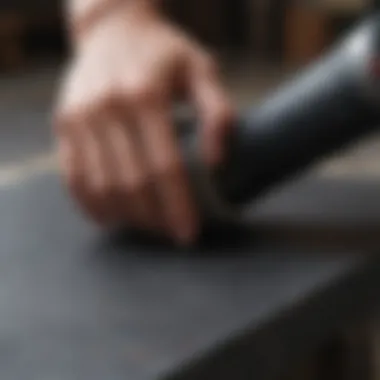
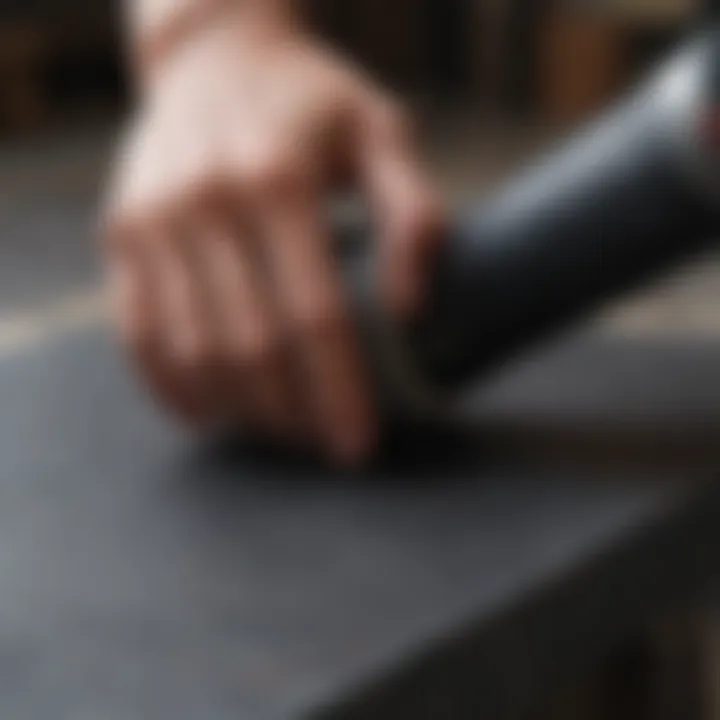
- Weather Factors: Wet and cold conditions affect tackiness. If riding in rainy regions, look for grip tape designed for optimal adhesion.
- Surface Types: The type of surface you will use is also critical. For instance, smooth surfaces might require a different grip material compared to rough terrains.
- Longevity: Assess how long you intend to use the tape. Some brands offer more durability, which can be crucial if you frequently ride in harsh environments.
"The right grip tape can make the difference between a thrilling ride and a hazardous fall."
In summary, when choosing the right grip tape, assess your specific needs and thoroughly evaluate the conditions where it will be used. This careful consideration will lead you to a product that enhances your performance and enjoyment in your chosen extreme sport.
Installation Techniques for Grip Tape
The installation process of grip tape is crucial for ensuring optimal performance in extreme sports. Proper application techniques significantly affect how well the grip tape adheres to the surface and functions during use. This section delves into essential aspects that affect installation, including surface preparation, the application process, and cutting and shaping the grip tape.
Preparing the Surface
Before installing grip tape, the surface must be adequately prepared. A clean, smooth surface promotes better adhesion and improves the grip tape's longevity. Begin by thoroughly cleaning the surface where the grip tape will be applied. Use isopropyl alcohol or a similar solvent to remove dust, dirt, and residue. After cleaning, allow the surface to dry completely.
Inspect the surface for any imperfections. Small scratches or bumps may cause the grip tape to lift or peel over time. If you encounter any imperfections, consider sanding them down or filling them in as needed. Ensuring a level application will prevent wear issues later. Remember, the longevity of grip tape greatly depends on how well it adheres initially.
Application Process
After preparing the surface, it is time for the application of the grip tape. Peel the back layer off the grip tape carefully. Take care not to touch the adhesive side, as skin oils can affect adhesion. Position the grip tape at one edge of the surface and lower it slowly while pressing down as you go.
As you apply the tape, avoid trapping air bubbles. If bubbles form, gently lift the tape and reapply it to eliminate them. A squeegee or a flat object can help smooth out the tape and ensure good contact with the surface. When the grip tape is secure, run your fingers over it to ensure there are no areas lifting or shifting. A proper application allows for optimal grip and enhances overall performance simply.
Cutting and Shaping
After the tape is applied, cutting and shaping become necessary to achieve a proper fit. Use a sharp utility knife or a scissors for precise cuts. Carefully trim the edges to match the surface outline accurately. It is helpful to make small, controlled cuts rather than trying to cut all at once, which can lead to uneven edges.
Pay special attention to corners and edges, as these are often areas prone to lifting. For those using the grip tape on skateboards, curving the edges slightly can prevent peeling.
Once cut, press down on all edges again to ensure they stick properly. This finishing touch is critical in maintaining grip tape performance and preventing premature wear.
Proper installation techniques extend the lifespan of grip tape while enhancing safety and performance.
Maintenance of Grip Tape
Maintaining grip tape is essential for optimizing its performance and extending its lifespan. Regular upkeep not only ensures that grip tape functions effectively but also contributes to the safety and overall experience of using extreme sports equipment. Grip tape can accumulate dirt, debris, and moisture, which can degrade its effectiveness. Therefore, practical maintenance can significantly enhance the longevity and performance of grip tape.
Cleaning Methods
Cleaning grip tape is a straightforward process that requires only a few simple steps. Keeping it clean helps maintain the traction needed during skateboarding, snowboarding, or surfing. Here are some effective methods to clean grip tape:
- Brush Cleaning: A stiff-bristle brush works well for removing loose dirt or debris. Regular brushing helps maintain the texture of the grip tape, ensuring optimal grip.
- Wet Cleaning: Occasionally, a mild soap solution can be used for deeper cleaning. Mix a small amount of soap with water, apply it gently with a soft cloth, and rinse thoroughly with water. Avoid soaking the tape, as excessive moisture can weaken the adhesive.
- Adhesive Remover: For tougher stains or adhesive residues from stickers, a specialized adhesive remover can be used. Make sure to apply it sparingly and wipe it off quickly to avoid damaging the tape.
By following these cleaning methods, individuals can keep their grip tape in top shape, ensuring it remains functional and safe for use.
Identifying Wear and Tear
Identifying wear and tear on grip tape is important to maintain performance and safety. As grip tape ages, it can show signs of degradation that affect its overall grip and adhesion. Here are some common signs to watch for:
- Surface Roughness: A smooth surface indicates that the grip tape has lost its texture. If the surface feels slippery, it is time for a replacement.
- Peeling Edges: Inspect the edges of the grip tape for any signs of peeling. Peeling can lead to further detachment, reducing the effectiveness of the grip tape.
- Cracks or Tears: Look for visible cracks or tears that can compromise the grip. Even small damages can worsen over time, affecting performance.
Regular inspections help prevent accidents caused by inadequate grip. Always replace grip tape if significant wear and tear is noticed.
By understanding cleaning methods and how to identify the signs of wear and tear, enthusiasts can effectively maintain their grip tape. This diligence ultimately leads to a safer and more enjoyable experience in extreme sports.
Common Issues with Grip Tape
Grip tape serves a critical function in extreme sports. However, it is not without its challenges. Understanding common issues is crucial for maintaining optimal performance and safety. Properly addressing these problems can enhance the longevity and effectiveness of grip tape. The two main areas of concern include peeling and lifting of the tape, as well as the gradual loss of grip over time. These issues can significantly impact a rider’s experience, making awareness and preventative measures essential.
Peeling and Lifting
Peeling and lifting of grip tape often occur due to poor installation or environmental factors. When the grip tape cannot adhere adequately to the surface, it begins to lift at the edges or in the center. This results in an unsafe riding experience. A few common causes include:
- Moisture: Water can weaken adhesive bonds, leading to lifting.
- Debris: Dirt or oil beneath the tape reduces adhesion often, especially if the surface was not cleaned thoroughly before application.
- Temperature: Extreme heat or cold can impact the adhesive's performance, causing it to react poorly.
Solutions to combat this issue include ensuring a clean and dry installation surface. Mechanically cleaning the area can improve adhesion. When fitting the tape, apply even pressure evenly across the entire surface to avoid air bubbles. Using heat during installation can activate the adhesive better if you live in a cooler climate.
"A properly applied grip tape enhances performance and safety, while poorly applied tape can create significant hazards."
Loss of Grip Over Time
The loss of grip is a natural process that occurs as the tape wears out. Several factors contribute to this deterioration:


- Material fatigue: Continuous friction and stress can gradually wear down the texture of the tape.
- Environmental exposure: Prolonged exposure to sunlight, water, and varying temperatures can deteriorate the material.
- User activity: Aggressive riding styles and techniques can significantly accelerate wear.
To minimize grip loss, routine inspection and cleaning are paramount. Consider replacing grip tape when you first notice diminished performance. Gripping characteristics can often be recovered temporarily through cleaning but replacing it is the only way to fully ensure its effectiveness. A timely replacement helps maintain performance and safety, allowing riders to enjoy their sports without compromise.
The Environmental Impact of Grip Tape
Grip tape is often overlooked when discussing the environmental footprints of extreme sports. However, its production and disposal can significantly affect our ecosystem. Understanding the environmental impact of grip tape is crucial, as it encourages transparency and responsibility among manufacturers and consumers alike. In this section, we will explore the sustainability of materials used in grip tape and the recycling options available.
Sustainability of Materials
When it comes to grip tape, the choice of materials directly influences its environmental friendliness. Traditional grip tapes are made from various synthetic materials, such as PVC and other plastics. These materials are not biodegradable. They can last for hundreds of years in landfills, contributing to the bad pollution issue. On the other hand, some brands are now shifting to more sustainable alternatives, such as hemp, cork, or recycled products. These materials are not only more eco-friendly but also provide excellent grip and durability.
Using naturally sourced or recycled materials can greatly reduce the carbon footprint of grip tape. The production of synthetic grip tapes is energy-intensive, whereas sustainable alternatives often require less energy to produce, resulting in lower greenhouse gas emissions. Furthermore, these industries promote a circular economy by reincorporating old materials into new products, reducing waste.
Recycling Options
Recycling options for grip tape are still limited but evolving. Some manufacturers have started to take back their used grip tape, allowing consumers to dispose of it responsibly. By returning used products, individuals can help minimize waste and limit the number of materials that end up in landfills. However, it is important to note that not all grip tapes are recyclable, especially those made from conventional plastics.
Consumers can also look for companies that offer recycling programs or initiatives. Some brands may partner with recycling firms or nonprofit organizations to promote green waste practices. Additionally, DIY recycling methods are becoming increasingly popular by cutting used grip tape into smaller pieces for various creative projects, such as art or crafts.
Future of Grip Tape Technology
The landscape of grip tape technology is rapidly evolving. As extreme sports continue to gain popularity, the demand for innovative solutions to enhance performance, safety, and comfort becomes crucial. Grip tape, which serves as a fundamental element in activities like skateboarding and snowboarding, is now receiving attention for its potential to improve grip and control on various surfaces.
Innovative Products on the Market
The current generation of grip tape products showcases technological advancements that cater to the needs of thrill-seekers and athletes. Some key innovations include:
- Responsive Grip: Many brands are developing grip tapes with materials that adjust based on conditions. For instance, grip tapes that offer increased adhesion when wet are becoming popular.
- Airflow Technology: Certain products now incorporate micro-perforations to enhance breathability, reducing moisture buildup. This feature is especially valuable for long sessions in the heat, improving comfort.
- Eco-Friendly Options: As environmental awareness grows, several companies are introducing grip tapes made from sustainable materials. These products aim to provide the same performance while reducing the environmental footprint.
- Customizable Designs: Innovative grip tapes now allow users to personalize their tape with colors and patterns, adding an artistic touch without compromising functionality.
These advancements highlight a blend of performance and aesthetics in grip tape technology, ensuring a product that meets the diverse needs of users.
Predictions for Trends in Grip Tape
Looking ahead, several trends are likely to shape the future of grip tape technology:
- Smart Grip Solutions: The integration of technology, such as sensors, could lead to grip tapes that provide real-time feedback during sports activities. This could assist athletes in monitoring their performance.
- Enhanced Durability: As sports equipment undergoes rigorous use, we can expect further developments in materials that resist tearing and wear while maintaining grip. Innovations in the durability of grip tape will also likely focus on making it easier to install and remove.
- Cross-Disciplinary Advances: Techniques and materials originally developed for other extreme sports might be adapted for grip tape. This includes insights from climbing or biking gear that could enhance grip tape performance for skateboarding and snowboarding.
- Collaboration Between Athletes and Brands: As sports authenticity becomes important, brands may increasingly collaborate with professional athletes to get direct feedback on grip tape performance, resulting in designs that more accurately reflect users’ needs.
Investments in these areas are expected to create products that not only perform better but also respond to the evolving demands of extreme sports enthusiasts.
Expert Opinions on Grip Tape
The voices of seasoned athletes and industry experts provide invaluable insights into grip tape. Understanding the perspectives of those who rely on this equipment daily can inform choices for both enthusiasts and newcomers in extreme sports. Their experience illuminates reasons why selecting the right grip tape can enhance performance and safety.
Insights from Professional Athletes
Professional athletes often choose specific grip tapes based on personal preference and performance needs. Many skateboarders and snowboarders highlight the importance of grip tape that offers a balance between stickiness and durability. For example, Tony Hawk emphasizes that a reliable grip tape can lead to more precision in tricks, ultimately affecting overall performance. Athletes often prefer brands like Jessup or Black Diamond because of their proven track records in high-performance environments.
Some athletes also mention how different weather conditions necessitate different types of grip tape. For instance, rainy or humid conditions require a grip tape that maintains its tackiness even when wet, preventing slips that could lead to accidents. Furthermore, athletes stress the role texture plays in feel. Those who are deeply invested in their sport often opt for custom-cut grips to suit their board shape or riding style.
"The right grip tape can be the difference between landing a trick or hitting the pavement." - Professional Snowboarder
Feedback from Industry Experts
Industry experts provide a broader outlook on grip tape's performance characteristics. They indicate that grip tape technology has evolved markedly over the years, offering specialized options for different sports. Experts like Paul Schmitt, owner of Schmitt Stix, speak about the materials used in modern grip tape production and how advancements have led to more efficient products. High-friction surfaces are now designed to endure wear and tear over extended use, thus, sustaining grip longer.
Additionally, feedback from experts often emphasizes the significance of proper installation. Many technicians in the field recommend utilizing specific installation techniques to maximize the lifespan of grip tape. Using a heat source to set the tape can prevent peeling, and ensuring the board surface is clean enhances adhesion. Experts suggest companies invest in high-quality grip tape, as it can save time and materials in the long run.
In summary, the insights from professional athletes and feedback from industry experts highlight how grip tape is not just a trivial accessory. Instead, it serves a critical function in optimizing performance, providing safety, and ensuring durability. As extreme sports continues to grow, understanding this specific element becomes increasingly important.
End
In this article, we have explored the critical role grip tape plays in enhancing the performance and safety of athletes in extreme sports. The key takeaways from this extensive guide shed light on the various types, materials, and performance characteristics of grip tape. Additionally, we touched upon installation techniques and maintenance practices that ensure longevity and effectiveness.
Understanding how grip tape affects control and stability can significantly influence an athlete’s experience. Grip tape is not just a simple accessory; it provides the necessary friction and support, which can impact the success of maneuvers in skateboarding, snowboarding, and surfing.
"Choosing the right grip tape can determine your performance and safety on the board."
When selecting grip tape, consider factors such as the material, texture, and environmental conditions in which you will be using it. These considerations can make the difference between a good ride and a challenging one. Extreme sports enthusiasts should prioritize grip tape that aligns with their specific needs and the particular activity they engage in.
Summary of Key Points
- Importance: Grip tape enhances control and stability for athletes.
- Types: There are different types of grip tapes tailored for skateboards, snowboards, and surfboards.
- Materials: Each material has its own advantages and disadvantages, affecting performance levels.
- Installation and Maintenance: Proper installation techniques and maintaining grip tape is crucial for long-term usability.
- Environmental Factors: Weather and terrain heavily influence the grip tape selection process.
Final Recommendations
- Choose Based on Activity: Always select grip tape designed specifically for the sport you practice.
- Evaluate Material Properties: Investigate the durability and texture of the grip tape prior to purchase.
- Practice Installation: Take time to learn the correct installation techniques to prevent common issues, such as peeling.
- Maintain Regularly: Regularly clean and inspect grip tape to extend its lifespan.
- Stay Updated: Keep an eye on new products entering the market to explore enhancements in grip tape technology.
By following these recommendations, athletes can enhance their performance while also ensuring safety in their extreme sports endeavors.







